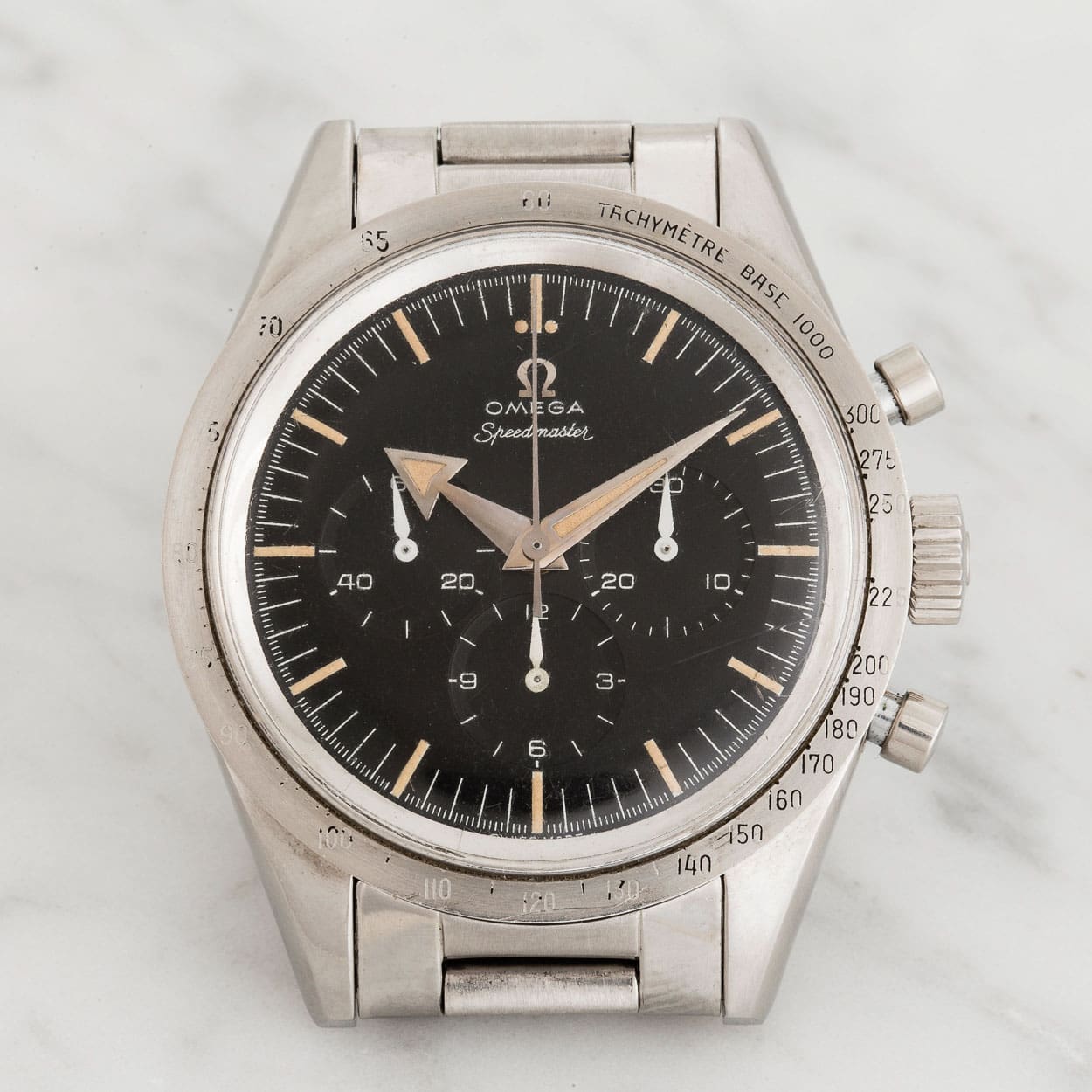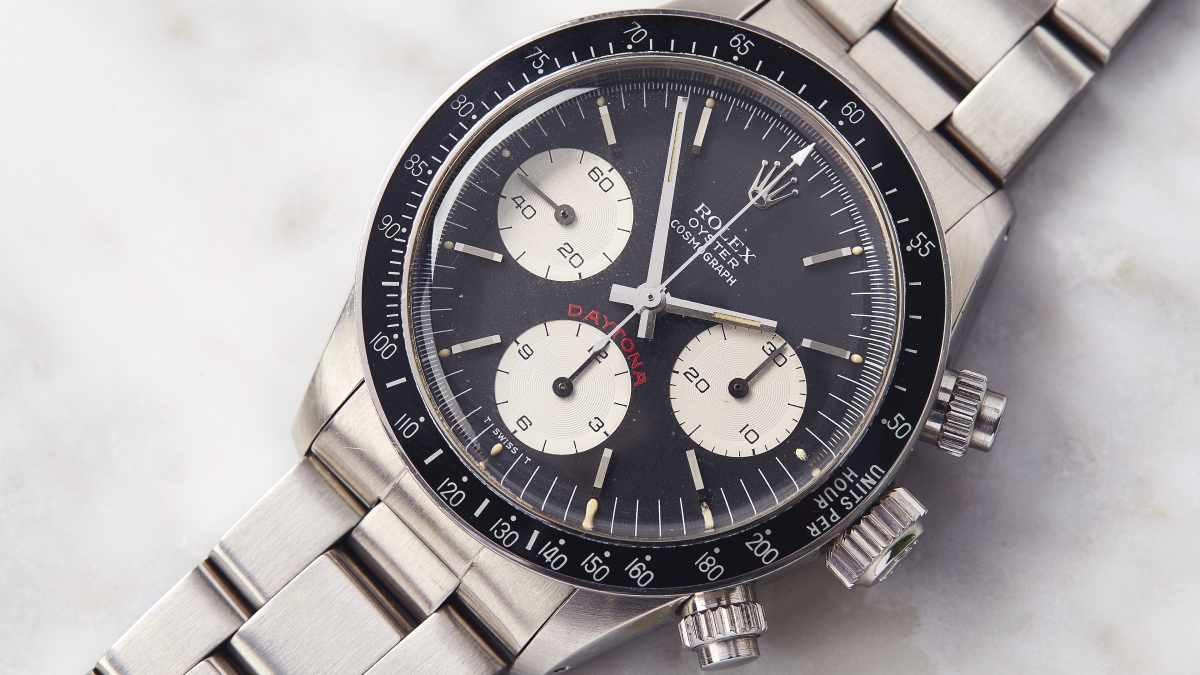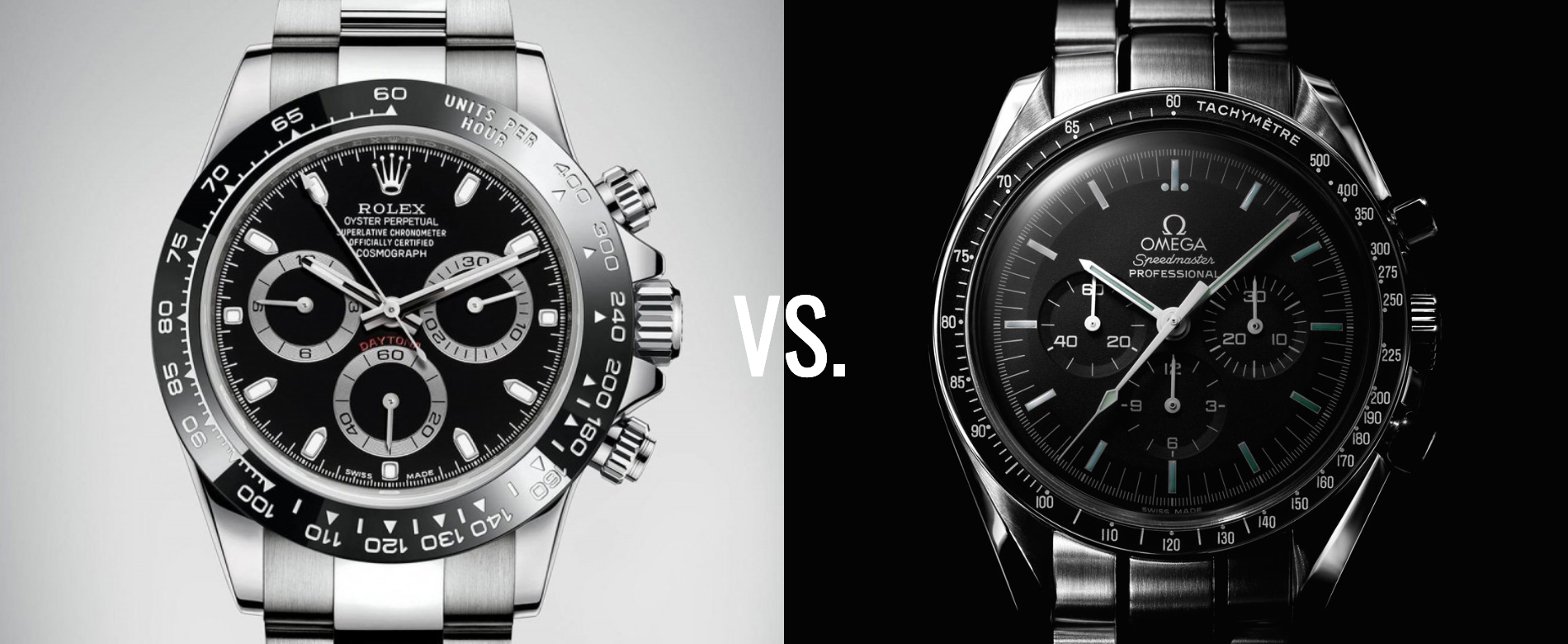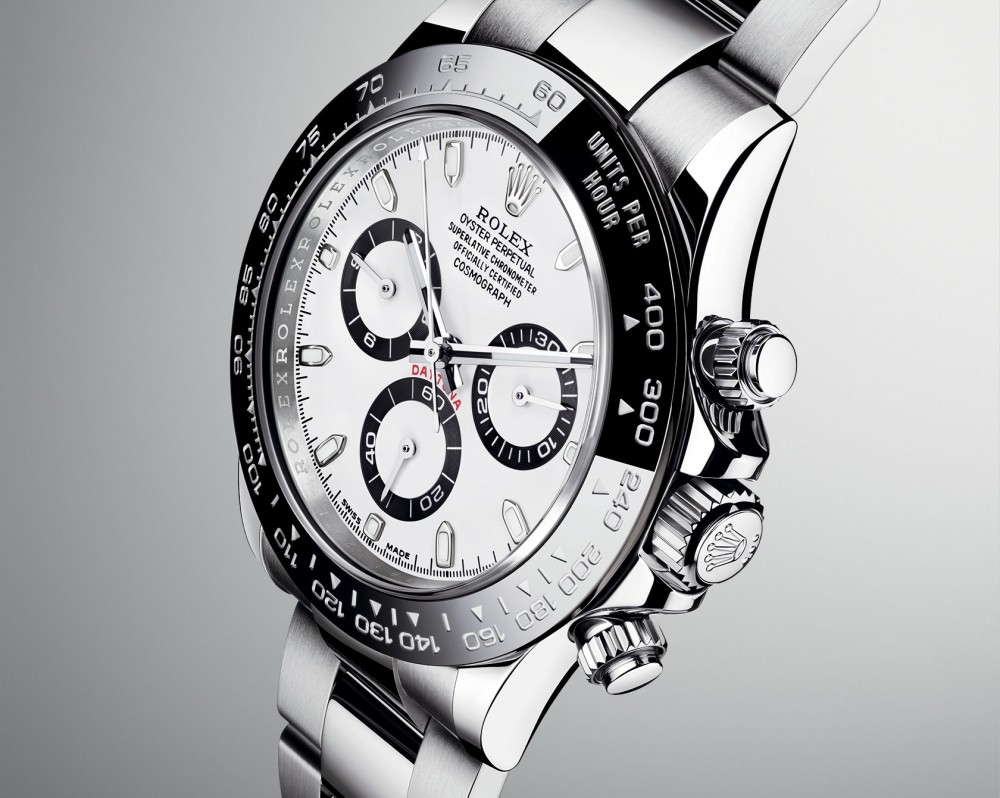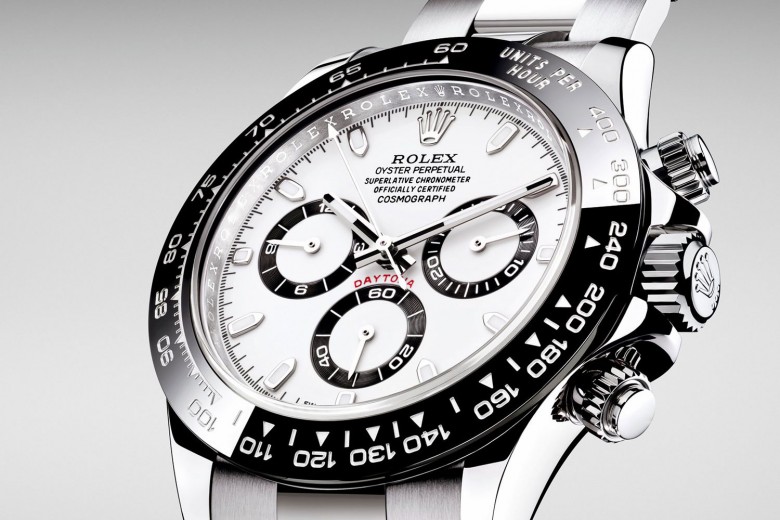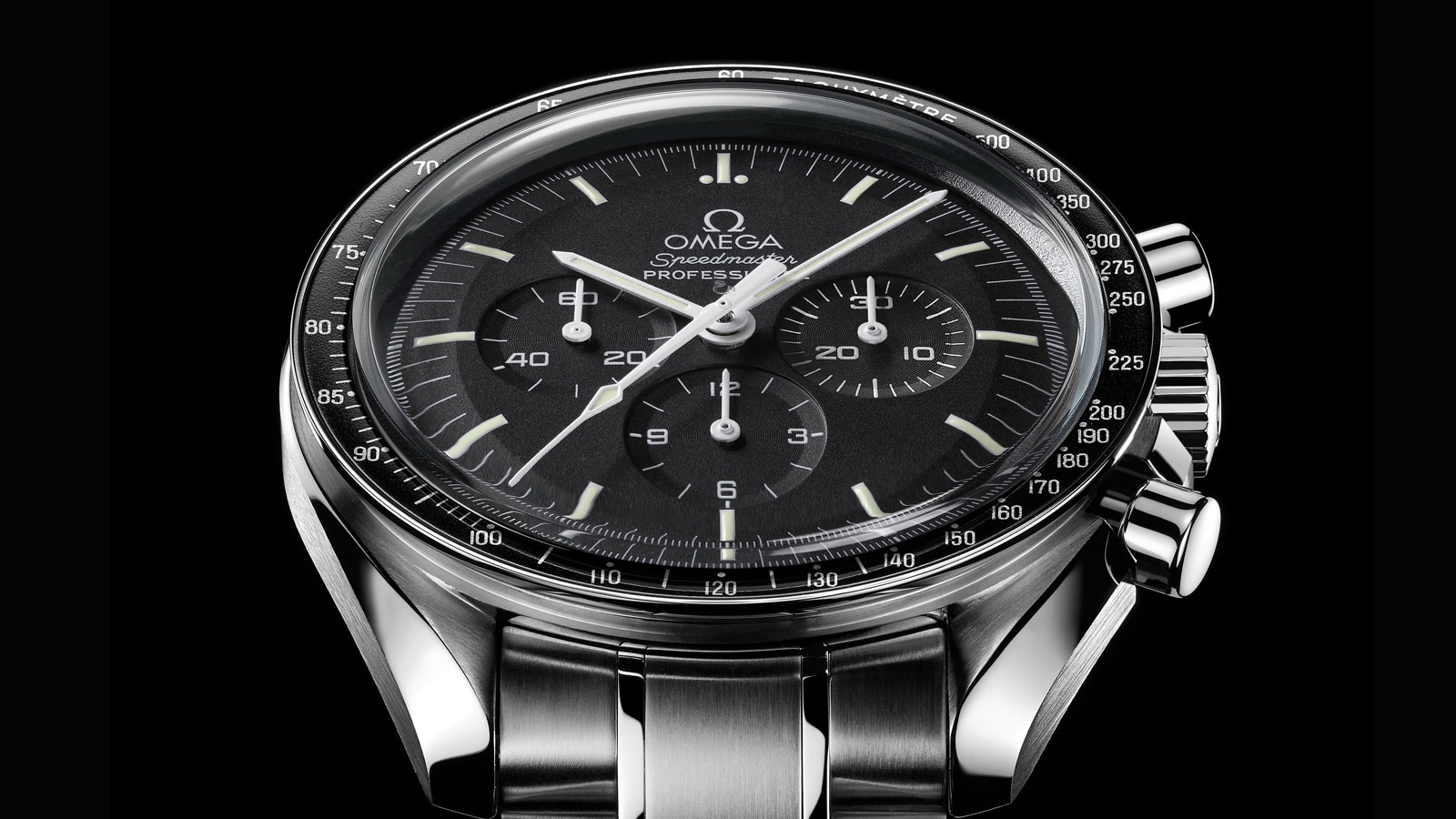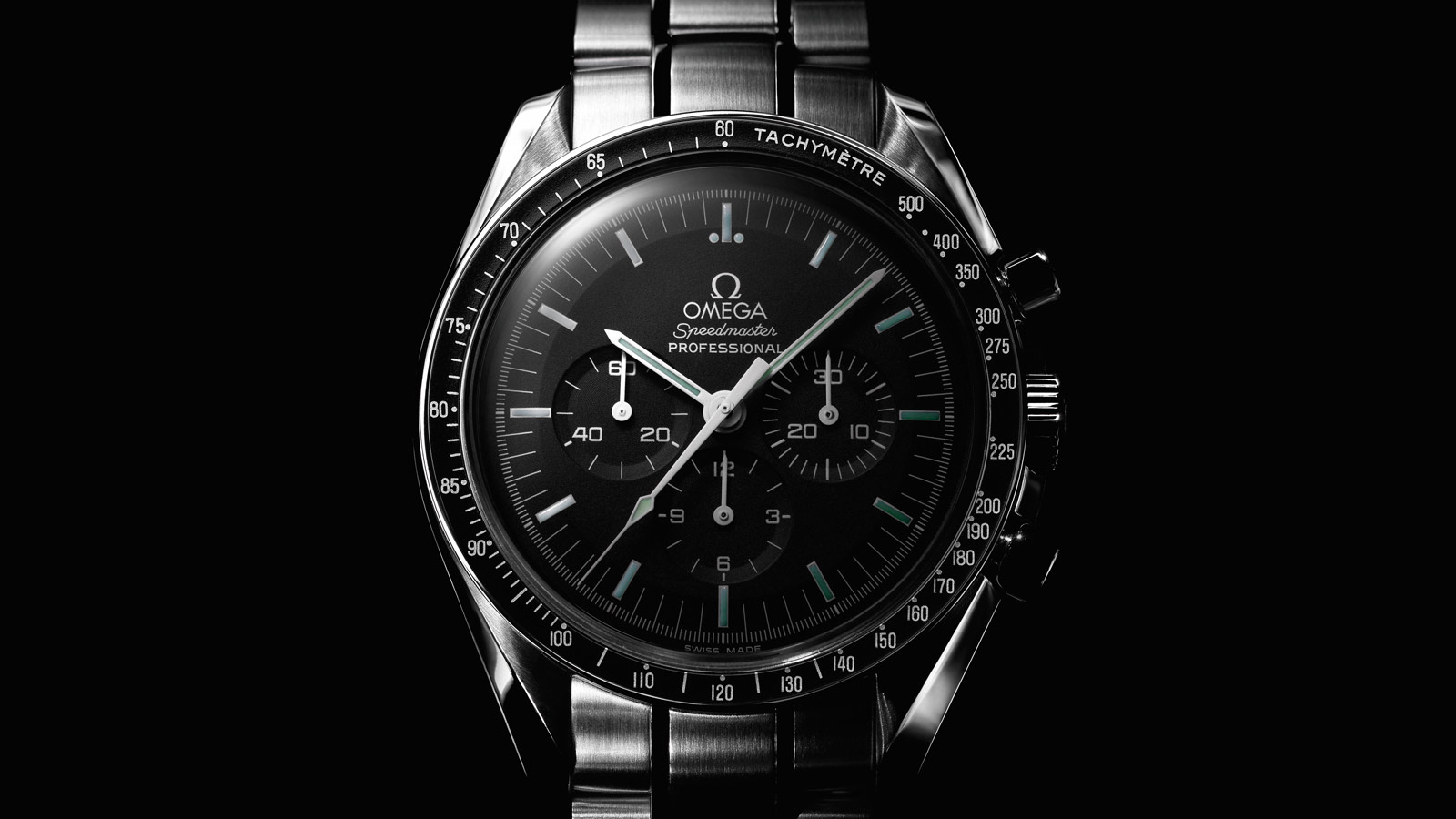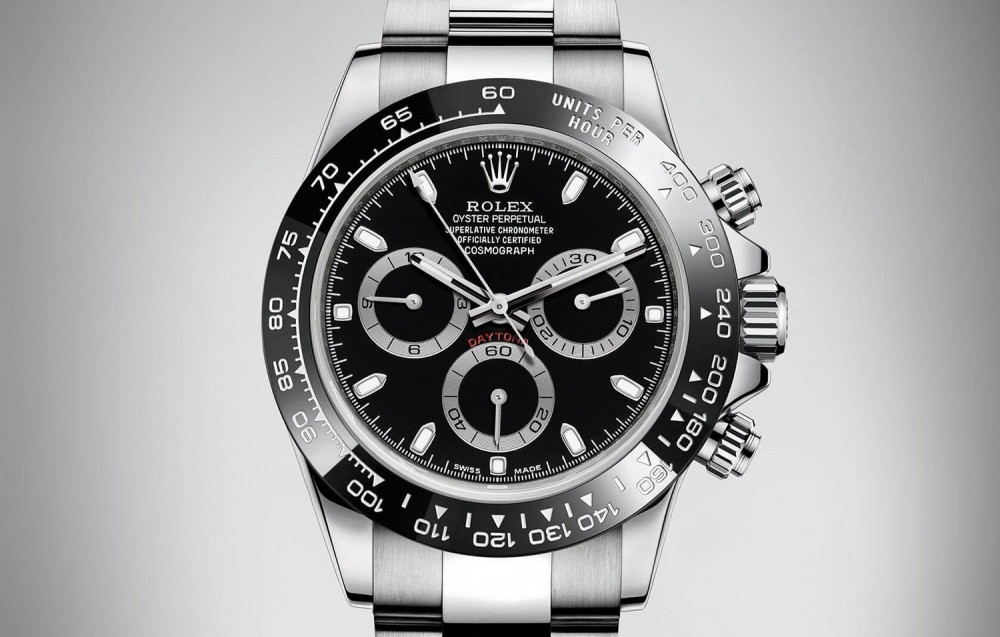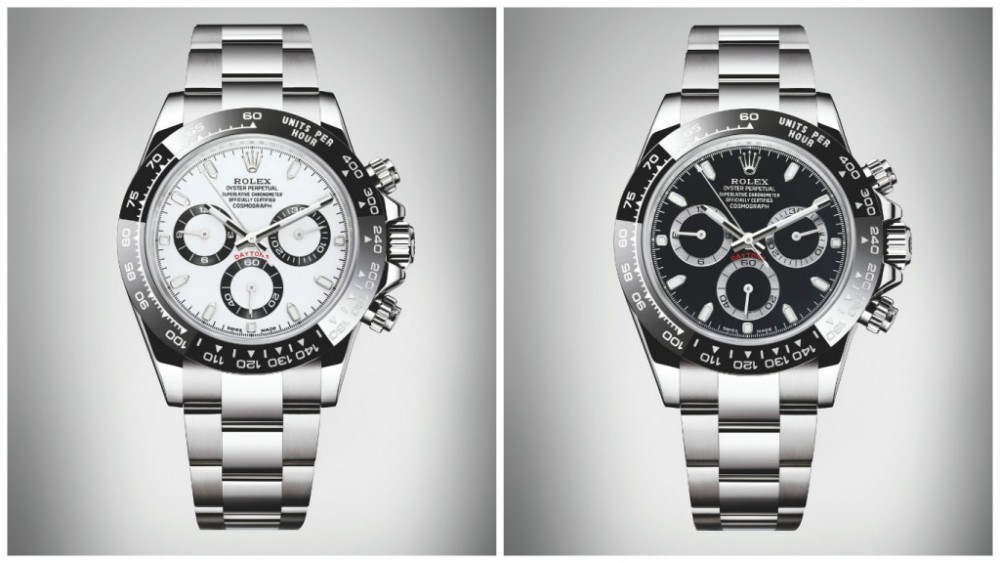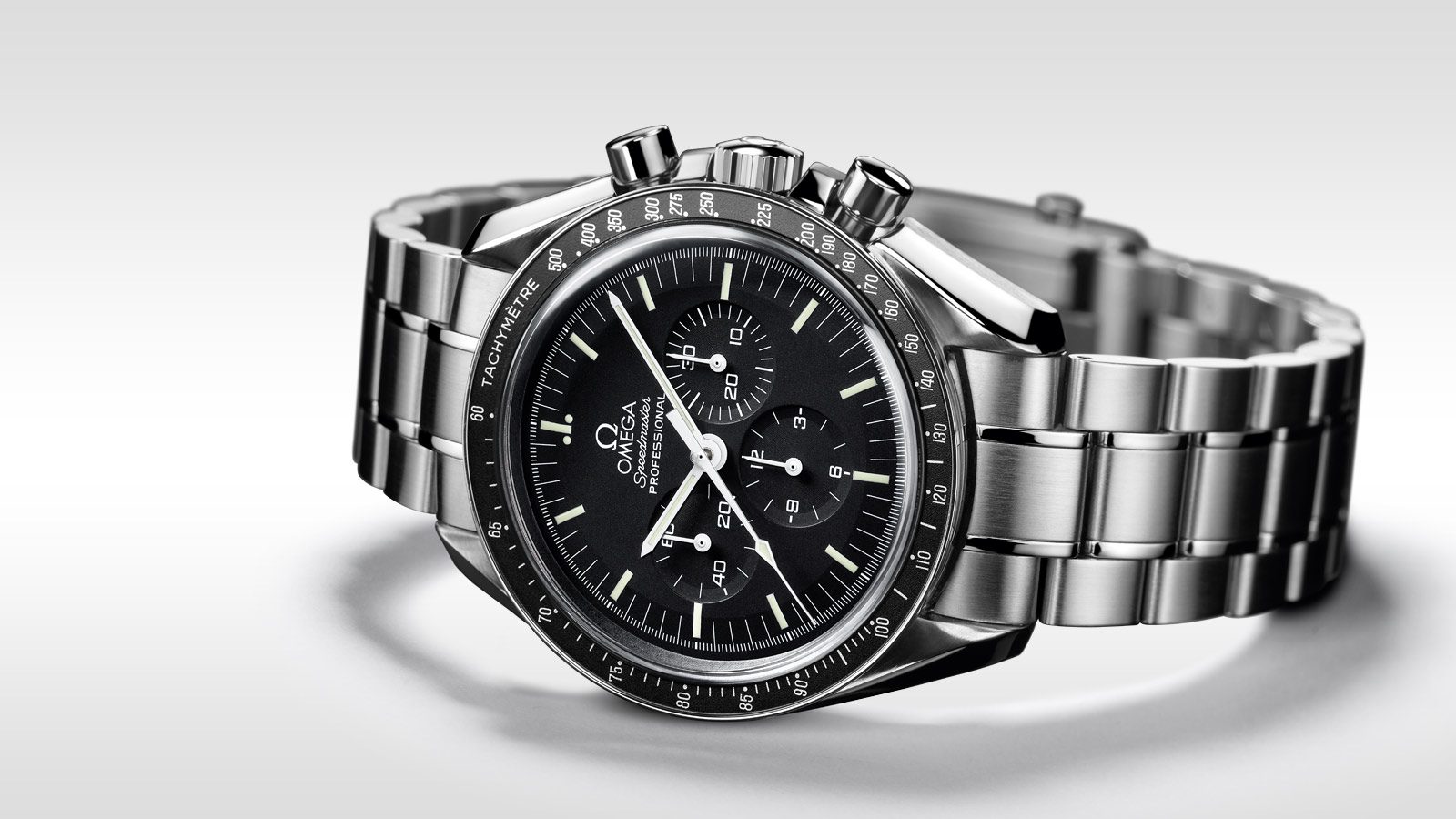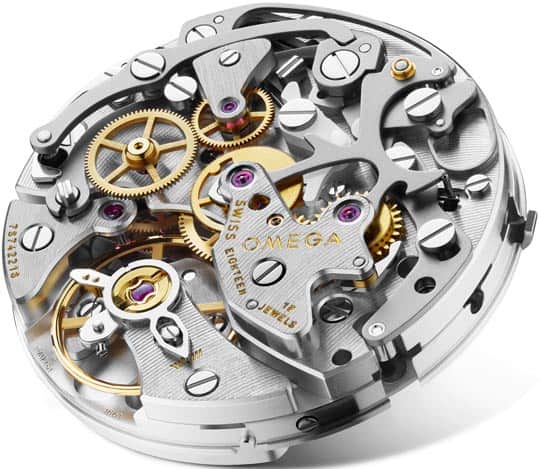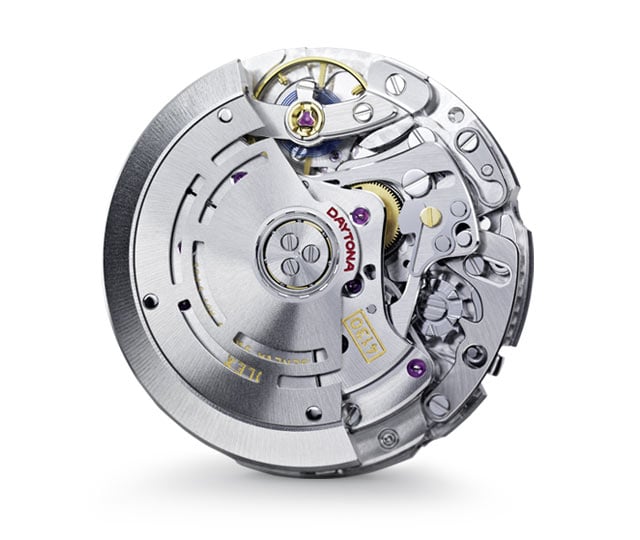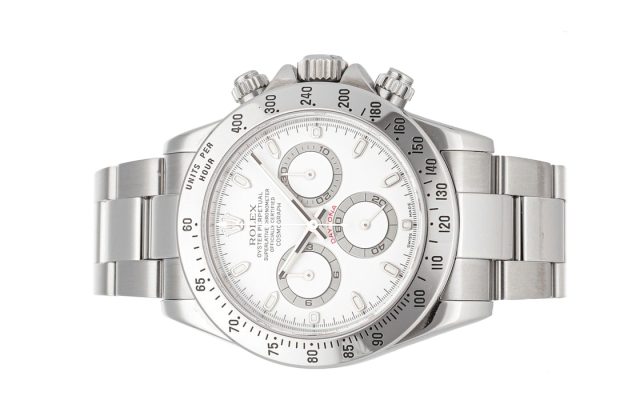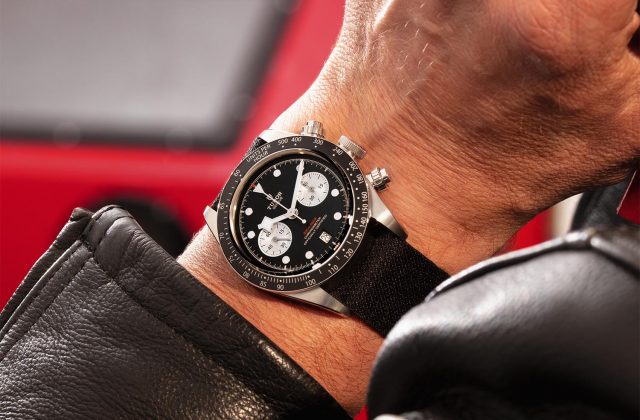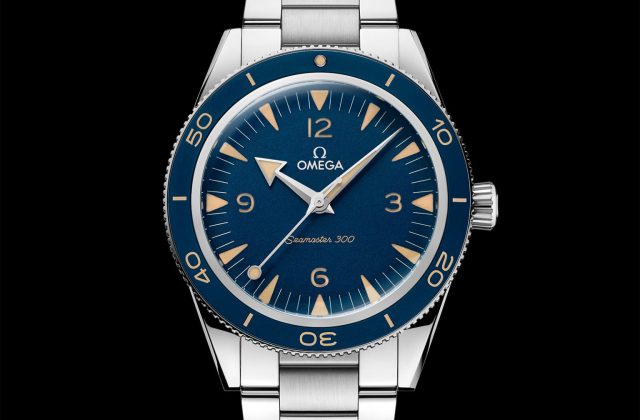The Rolex Cosmograph Daytona 116500LN is one of the most sought-after steel luxury watches in the world. Bar none. It’s impossible to buy new from an authorized Rolex agent. That means you can expect to pay close to double retail on the secondary market. The Omega Speedmaster Moonwatch Professional Chronograph ref 311.30.42.30.01.005 meanwhile, trades at about 20% below retail on the secondary market. It costs about a third as much as a Rolex Daytona new, and offers exactly the same functionality. It’s also the only watch ever approved by NASA for space travel. Could it be then that the Omega Speedmaster offers better value than the Rolex Daytona?
This seems like a reasonable question that should have a straight-forward answer. The reality is of course far more nuanced than that. Personal preference plays a role too of course. So, what is the right response? To help you decide, we’ve put together a comparison of these two popular models.
A (Brief) History Of The First Rolex Daytona And Omega Speedmaster Professional
It may surprise you to learn that the Omega Speedmaster precedes the Rolex Daytona by several years. It was launched in 1957 as part of Omega’s trilogy “Professional” collection. This also included the Seamaster 300 and the Railmaster. By this stage Omega had already established a reputation for chronograph watches. Rolex had not.
The first Speedmaster model was the reference CK2915, now sought-after by collectors. It features an hour-hand tipped with a broad-arrow and a baton-shaped second hand. It is also the first chronograph to feature a tachymeter on the bezel instead of on the dial. Nowadays this is the standard design used on most chronographs. Including of course the Rolex Daytona.
- An Omega Speedmaster CK2915-1 from 1958. Courtesy of Bukowskis.
What Is A Tachymeter? – A tachymeter (pronounced /tæˈkɪmətər/) scale is a scale sometimes inscribed around the rim of an analog watch with a chronograph. It can be used to compute a speed based on travel time or measure distance based on speed. The spacings between the marks on the tachymeter dial are therefore proportional to 1⁄t, where t is the elapsed time. Source: Wikipedia.
Inside was the manually-wound Calibre 321, developed by Omega and Lemania in 1942. A legendary movement, it has recently gone back into production after a 50-year hiatus. In 1965, NASA qualified the Speedmaster for use on its piloted missions. It was worn on all six lunar landings and to this day still goes by the nickname “the Moonwatch”.
Two years earlier, in 1963, the Rolex Cosmograph Daytona Ref 6239, made its official debut. Inside was the manual-wind Valjoux Caliber 72, modified by Rolex. This wasn’t the first chronograph model from Rolex. In fact, the brand already had some experience with this type of watch, but they did not sell well. It was however the first designed for professional racing drivers. As you can see, it looked a lot like the Speedmaster. The dial features a 3, 6, 9 lay-out for the sub-dials and a steel bezel engraved with a tachymetre scale. The font on the tachymeter scale is larger though, to make it easier to read at a glance.
The introduction of a racing chronograph followed the brand’s growing involvement in motorsport. In 1962, Rolex had become the official timekeeper of the Daytona International Speedway. The watch was not immediately called the Daytona though. Rolex actually used the name Le Mans in some advertisements for its new chronograph. Daytona was later chosen to emphasize the brand’s connection to the American racetrack. As a result, the word “Daytona” didn’t appear on the dial until 1965. And it wasn’t used consistently until around 1970 with Ref 6241.
- A preowned Rolex “Big Red” Daytona Ref 6263 courtesy of Xupes.
1965 was also the year Rolex introduced a variation of the Ref 6239 with exotic dials. These distinctive dials are identifiable by a few key shared characteristics:
- an outer track, matching the sub-dials, runs around the edge of the dial;
- sub-dials with cross-hairs meeting at centre and block markers instead of lines;
- the seconds sub-dial placed at 9 o’clock has markings at 15, 30, 45 and 60, instead of at 20, 40 and 60 as in the standard dials.
These dials proved a little too exotic for the time though. Consequently, they were produced in limited numbers. Of course, they did have one notable fan in that of movie star and race car driver Paul Newman. That is a story for another day though. To understand what makes a Daytona a Paul Newman Daytona see this explanation from Sotheby’s.
Roughly sixty years on, the Omega Speedmaster and Rolex Daytona have become icons of modern watchmaking. They’re similar in design and execution. Yet, they sit at very different points on the price spectrum. So, what makes one so much more expensive – and desirable – than the other? And how much more do you get for your money with the Rolex?
We’ve laid out the facts below so you can decide for yourself.
Omega Speedmaster Moonwatch Professional Chronograph vs Rolex Cosmograph Daytona 116500LN
Case
The Rolex Cosmograph Daytona 116500LN comes in a 40mm Oyster case made from Oystersteel. Developed by the brand, Oystersteel belongs to the 904L steel family. According to Wikipedia, Rolex chose this variety of steel because it takes a higher polish than lower grades. It also provides greater corrosion resistance. In contrast, most watch brands opt for 304L or 316L steel for their watch cases. It’s cheaper and easier to machine.
Omega doesn’t disclose what type of steel it uses for the 42mm case of the Speedmaster Moonwatch Professional Chronograph (ref. 311.30.42.30.01.005). I’m assuming that it’s 316L steel. In reality, this is more than sufficient. The decision to use 904L steel is yet another example of Rolex over-engineering its watches to create the best product possible.
The Oyster case also means the Daytona is waterproof to 100m, unusual for a chronograph watch. Rolex created the first waterproof watch in 1926. Now most models in the collection use this legendary case construction. The middle section is stamped and machined out of a solid block of Oystersteel. Once the movement is in place, the back of the case is hermetically screwed down against the middle case. The winding crown and chronograph pushers are also screwed hermetically onto the case. The crown is protected by the Triplock triple waterproofness system.
In contrast, the Speedmaster is waterproof to 50m. It does not have a screw-in crown or chronograph pushers. This won’t be a deal breaker for most as it’s a racing watch. If you want a robust dive watch, there’s the Omega Seamaster Diver 300M. Or, if you’re feeling particularly extreme, the Rolex Deepsea Ref 126660.
Bezel
When the Rolex Cosmograph Daytona 116500LN debuted in 2016, it created quite a stir. The reason for this was the introduction of a black monobloc Cerachrom bezel in ceramic with engraved tachymetric scale. Virtually scratchproof, the Daytona was the last of the Rolex tool watches not to have a ceramic bezel.
The thinner, alumninum bezel insert on the Speedmaster is less fancy. Also black, its tachymetric scale is printed not engraved. The downsides to this of course are that its subject to fading and scratching over time. Some enthusiasts will tell you that’s a good thing though. It means your watch will become personalised to you. Whereas the Daytona will never age, even as you do. Think of it as a Picture of Dorian Gray for your wrist.
Dial & Hands
The dial of the Speedmaster comes in black only. It’s often praised for its excellent legibility. The steel central hour and minute hands are lume-filled. So too is the chronograph seconds hand. The classic 3/6/9 layout of the sub-dials is both attractive and functional. Running seconds are at 9 o’clock, while a 30-minute recorder and 12-hour recorder appear at 3 and 6 o’clock respectively. All text on the dial is white, as are the dial markings. This creates a high level of contrast against the black dial, again making for easy reading.
The dial layout of the Daytona is quite similar. Look closer though and you’ll spot several key differences. For a start, the Rolex offering is available with a black or white lacquer dial. The former features grey snailed counters, while the latter has black snailed counters. The hands and hour markers are made from white gold and treated with Chromalight luminescent material. The dial configuration is also different. The chronograph hour and minute counters are shown at 9 and 3 o’clock. Running seconds are on the sub-dial at 6 o’clock.
The other notable difference is that the dial of the Daytona is protected by a scratch-resistant sapphire crystal. This is common in high-end luxury watches. The Speedmaster though has a domed Hesalite (acrylic) crystal. It’s much more prone to scratching, but those scratches are generally easy to buff out. More importantly though, it’s historically accurate. The original Speedmaster Professionals that went to the Moon were all fitted with acrylic crystals. Sapphire crystal wasn’t used widely back then like it is now, plus acrylic is less inclined to shatter if broken.
Bracelet
The Daytona comes on a Rolex Oyster bracelet. Considered one of the best steel watch bracelets in the industry, it is very comfortable. Held in place via the folding Oysterlock safety clasp, it features the Easylink 5 mm comfort extension link. This means you can fine tune the length of the bracelet without removing any links or using any tools.
The steel bracelet on the Speedmaster is also well executed. It’s not to the same level as the Oyster bracelet but very few bracelets are. The integrated bracelet on the AP Royal Oak The brushed finish lets you know it’s a tool watch, although the outer edges of the links are polished for some contrast. It also comes with a NATO strap.
Movement
When it comes to mechanical watches, the movement is what separates the good from the great. And this is where we find the fundamental difference between the Daytona and the Speedmaster.
Inside the Omega is the manually-wound 1861 Calibre. It’s an evolution of the 861 Calibre that was used in the watches that went to the Moon. Introduced in 1997, it offers a max power reserve of 48 hours. In reality you will need to wind it daily to keep it running accurately. It is not chronometer certified and the accuracy range is approximately -1/+11 seconds a day. A robust and reliable movement but one without any bells and whistles.
The Rolex meanwhile houses the self-winding Calibre 4130. A manufacture movement, it is certified as a superlative chronometer. That means it’s guaranteed accurate to -2/+2 seconds a day after casing. The chronograph movement features a Parachrom hairspring. This offers greater resistance to shocks and to temperature variations. When wound it gives 72 hours of power reserve.
Price & Availability
This is where things get interesting. The Omega Speedmaster Moonwatch Professional Chronograph (ref. 311.30.42.30.01.005) retails for GBP 3,680. It’s available from most authorised dealers and is excellent value for the money. Not only is it a great looking watch with impeccable heritage, it also comes with a 5-year warranty.
The Rolex Cosmograph Daytona 116500LN retails for GBP 9,550. The only problem is it’s impossible to find one new at an authorised retailer. If you’re long-term client that has spent a lot of money over the years, you might get a look in. Even then, expect to spend a long time on a waiting list. If you don’t want to wait and you have the money burning a hole in your pocket, you can always turn to the secondary market. The average price on Chrono24 at the time of writing is around GBP 17,000. Not as outrageous as the Patek Nautilus but still a 78% premium on retail.
Which Offers Better Value?
Both models deliver the same functionality. Yet, the Rolex Cosmograph Daytona 116500LN is the superior watch. On paper at least. Is it worth paying between three and five times as much as the Speedmaster for though? In other words, are you getting 3 – 5 times as much value?
Arguably, the answer is yes. The Daytona is a great looking, high-quality chronograph with unbeatable brand recognition. It’s unlikely to ever go down in value, and you will always be able to sell it if you need to liquidate some funds in a hurry. That doesn’t mean the Omega Speedmaster Professional isn’t a great buy too though. Most collectors will tell you that every watch nut should own a Speedmaster at least once. Ditto for the Daytona.
It all comes down to what you can afford, what you’re willing to pay and how long you want to wait.
Technical Specifications: Rolex Cosmograph Daytona Ref 116500LN
- Case: Oyster – 40 mm – Oystersteel – monobloc middle case, screw-down case back and winding crown – black monobloc Cerachrom bezel in ceramic with engraved tachymetric scale – waterproof to 100 metres / 330 feet.
- Dial: Available in black or white – centre hour, minute and seconds hands, small seconds hand at 6 o’clock. Chronograph (centre hand) accurate to within 1/8 of a second, 30-minute counter at 3 o’clock and 12-hour counter at 9 o’clock – stop seconds for precise time setting – Chromalight display with longlasting luminescence on hour markers and hands.
- Movement: Calibre 4130 – bidirectional self-winding via Perpetual rotor – paramagnetic blue Parachrom hairspring – 72-hour power reserve – certified as Superlative Chronometer.
- Price: GBP 9,100 (new) / ~GBP 17,000 (secondary market).
Technical Specifications: Omega Speedmaster Moonwatch Professional Chronograph 42 MM Ref 311.30.42.30.01.005
- Case: 42mm –steel – solid case back with special Moon watch engraving – black aluminium bezel insert with printed tachymetric scale – waterproof to 50 metres / 165 feet.
- Dial: Black – centre hour, minute and seconds hands, small seconds hand at 9 o’clock. Chronograph (centre hand), 30-minute counter at 3 o’clock and 12-hour counter at 6 o’clock –luminescent coating on hour markers and hands.
- Movement: Omega 1861 – manual-winding – non-hacking – 48-hour power reserve – 21,600 vph.
- Price: GBP 3,680 (new) / ~GBP 3,085 (secondary market).
This article by TheWatchLounge has been sponsored by our partner WatchBox.
